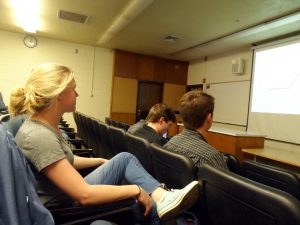BYU student Amanda McFarland watches her professor lecture on her personal computer rather than driving 30 minutes to campus to attend a lecture, and she said she loves it.
A recent study published in the American Journal of Surgery found students preferred integrating technology into their curriculum, and the inclusion of technology didn’t inhibit students’ ability to learn material.
Professors at Johns Hopkins University School of Medicine created a program that included online curriculum to accompany a surgical clerkship, a six-week program to teach students about principles of surgery.
After completing the program, the students were surveyed about their experience.
“Student exam scores and evaluations completed after the Hopkins program ended revealed that the experience significantly increased student satisfaction with the curriculum, while resulting in non-inferior academic outcomes,” according to the study.
Researchers found the following based on respondents’ answers:
- 66.5 percent had a positive experience with the online course
- 77.6 percent said technology-integrated learning — including online content, audio, visual — helped them better understand complex concepts
- 73.6 percent said the technology-integrated learning gave them more chances to practice the material
- 69.9 percent said technology-integrated learning provided better collaboration with classmates
- 1.6 percent prefer courses with no face-to-face interaction, and all coursework being online
- 53.6 percent preferred “extensive use of technology” in a course
- 54.4 percent said technology-integrated coursework improves learning
- 92 percent said technology allowed more flexibility in completing coursework from various locations

BYU freshman David Nilson took a chemistry course that requires three in-class lectures, two in-person labs and three online homework assignments on a program called SmartWork. He said SmartWork allowed him to apply what he learned in class.
He said the best feature of SmartWork is it “gives hints” to help the student answer the question, provides a step-by-step answer if the student answers incorrectly and allows three chances — something his textbook didn’t.
The downsides to SmartWork were that it counted slight variations in answers are counted as incorrect, even if they are mostly correct, and sometimes the questions didn’t make sense, according to Nilson. But he said the combination of in-person class time and online work was a positive experience.
Effectively integrating technology in the classroom
BYU education professor Royce Kimmons specializes in the use of technology in education. He said the key to using technology effectively depends on what the students do with the technology and the impact it has on teaching.
Kimmons uses the acronym PICRAT to teach faculty to improve how they use technology in the classroom. The acronym stands for passive, interactive, creative, replacing, amplification, transformation. He said the ideal use of technology combines creativity with transformation. An example would be having students use a Powerpoint to create a game to help learn concepts.

Simmons said there is no best technology to integrate in the classroom.
“It’s much less about the technology itself, and it’s much more about how we’re using it,” Kimmons said.
Online courses and overcoming obstacles
The study examining how surgical students reacted to online learning said those who took the course missed the teacher-student interaction when doing the online coursework.
McFarland, a BYU mechanical engineering student, is currently enrolled in a soils class, which includes occasional video lectures in place of in-person lectures. While she has the option to watch the lecture in the classroom, she said she chooses to watch it at home.

Because she works, studies and cares for her son, she says having an extra hour is convenient for her. However, she said the negative side to watching the video lecture is she can’t ask her professor the questions she has right away. McFarland said she has to figure out the answer herself, seek the help of a teaching assistant or email the professor.
Kimmons said there’s always been tension among those studying educational technology between worrying about the quality of education and moving coursework into a different medium, especially one with the goal to outsource to a larger group.
But he said online courses can include features to overcome the barrier of weakened student-teacher interaction, such as video conference calls and group discussion boards.
“We tend to have the mentality that if we can just put content in front of people, they’ll magically learn, and that’s not how it works,” Kimmons said.
Online coursework provides options
McFarland has also taken a few BYU Online courses. She said the courses range in difficulty, but she enjoys them.
“I love that they’re implementing more and more of that — like, for my situation, I feel that’s really great,” McFarland said. “Whenever I can do an online class, it’s really great for me and my family.”




